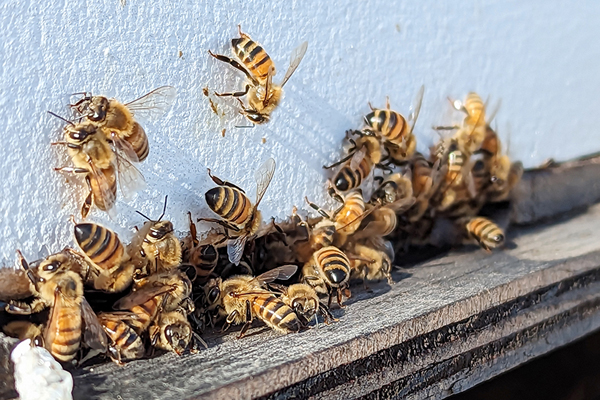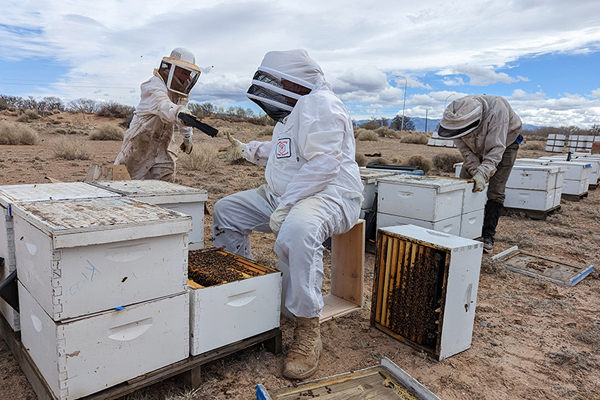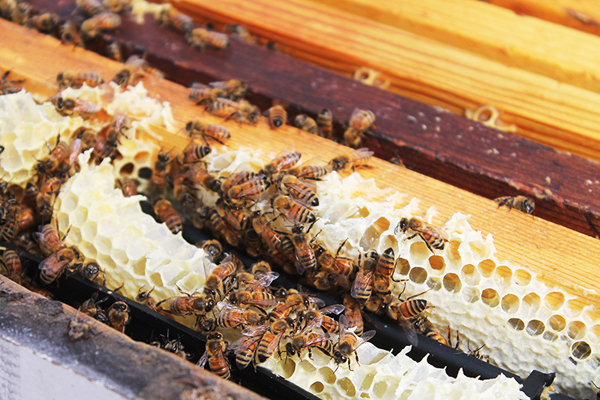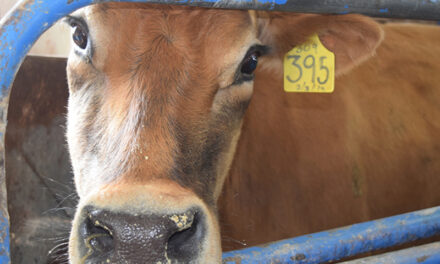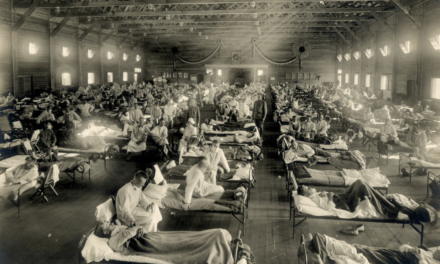BELEN — It was after sundown when the semi left the California almond groves last Monday. After a route change to avoid snow, a brief stop in Mesa, Ariz., and a delay on Interstate 10, the truck finally pulled off Interstate 25 in Belen.
In the dark of night, in an empty lot at exit 195, more than 12 million honey bees were returned home Tuesday evening. Housed in 312 white wooden hives, the bees hummed quietly to themselves.
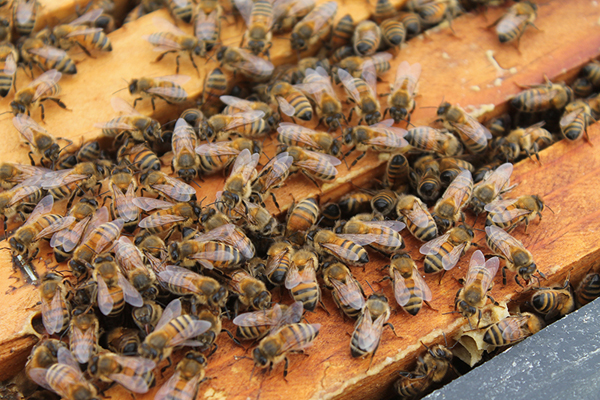
Julia M. Dendinger | News-Bulletin photos
Even as human beekeepers opened a hive, the bees just kept working, their wings reflecting tiny pieces of the New Mexico sky.
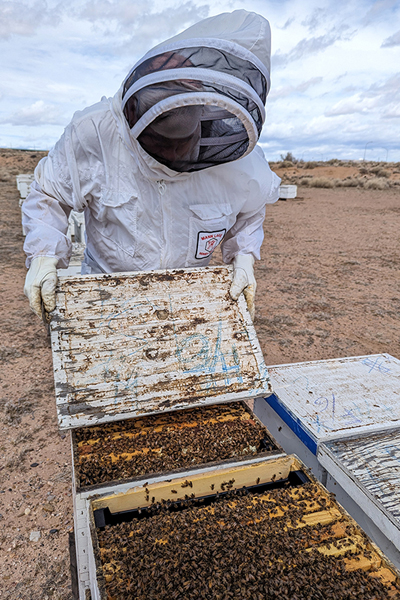
Ed Costanza has been beekeeping since he was 14 years old.
While he can work with the bees without a suit, he says it’s necessary with large numbers of hives like he was working with last week.
By mid morning Wednesday, as the winds whipped across the desert, Ed Costanza and his crew — Joey Wroten, Harold Wroten and Alan Chavez — were out at the bee yard to check the hives and get the bees ready for the heavy lifting of spring time in New Mexico.
Since he was 14 years old, Costanza has been wrangling bees and harvesting their honey. His name might ring a bell to locals — his parents, Robert and Jackie Costanza, established the Costanza Orchards in Belen in 1962 with the help of their six children.
The original 550 tree-orchard has grown to more than 1,100 trees. The orchards are the perfect example of the importance of honey bees, as the home to more than 100 hives to pollinate the trees.
When the trees were planted on the property to the east was a beekeeper with 25 hives. A few years after, he died and the Costanzas bought the property.
“And the bees came with it,” recalls Ed, speaking of the beginning of nearly 60 years in beekeeping. “I was really interested in the bees. I just don’t have the fear.”
After being stung multiple times and ending up in the hospital, Robert turned the care taking of the hives over to Ed. Over the decades, Costanza and his wife, Louella, have built a thriving business based around the bees.
A-Bee Honey provides local honey, pollen, bee packages for those wanting to try their hand at beekeeping and beekeeping classes, as well as information about reducing your property taxes with honey bees.
“We do get a lot of resources from them. There’s the honey, the beeswax, the propolis (a resin-like material made by the bees from tree sap), the royal jelly,” Costanza said. “The honey is probably the biggest thing but the pollination is really the key.”
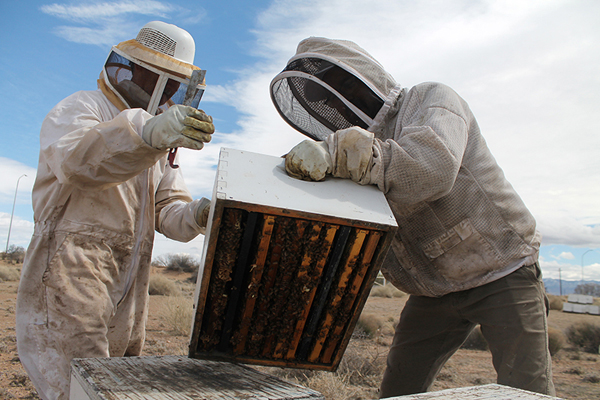
Harold Wroten and Alan Chavez open up a hive to check for queen cells and make sure the bees are healthy.
The 300-plus hives dropped on the northern edge of the Hub City have been in the California almond groves since the beginning of February. Now that the bees have pollinated the groves, they are back in New Mexico to pollinate locally and create honey over the summer.
“From February to about the middle of March, millions of bee hives go to California to pollinate the almonds. They need the bees, so they pay us a good fee to bring our bees out there,” says Costanza. “It makes some of the best honey you’ve ever tasted.”
With the hives back, Costanza and his helpers are going through the hives to separate out queens and establish new hives, which prevents them from swarming and losing a hive.
Bees will “swarm” or leave a hive for a few different reasons, he said, including an aging queen. With a life expectancy of about five years, each year the queen’s egg production drops off and her pheromone production decreases.
As a hive population declines, there are fewer worker bees to go out and harvest nectar and other resources, which doesn’t help the beekeeper with honey production and can cause the hive to die out during the winter.
While a low population is a risk to a hive, so is overcrowding. When there is a high volume of nectar coming into the hive and bees are reproducing at a high rate, a swarm can also happen.
“They’re filling everything up, so it’s a natural response by the bees that they’ll trigger a swarm,” Costanza said.
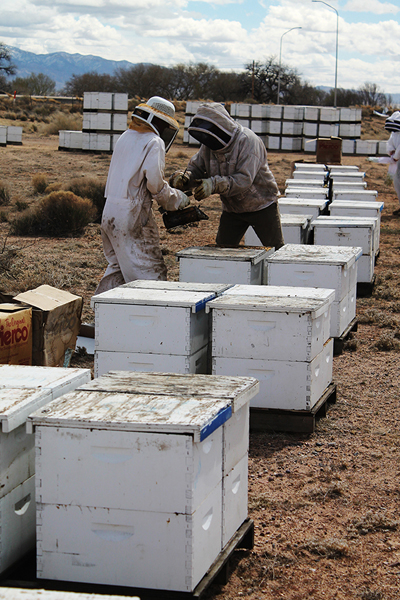
Beekeepers with A-Bee Honey check hives delivered last week, using cedar smoke to keep the bees calm.
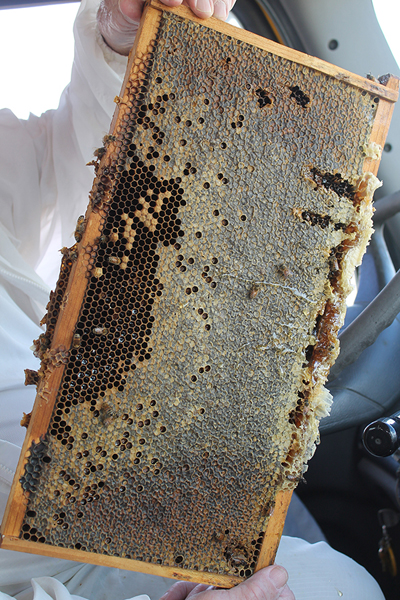
When the hive hits a tipping point, half of it along with a queen will lift off and leave, typically taking up temporary residence in a nearby tree.
They stay in the tree for about 24 hours while scout bees go out, looking for a new location. When they return, the scout bees do different dances to indicate the most popular new home.
“The best report that comes in, those bees will lift off and they will go to that new home and establish a hive there,” he said. “The queen will mate and start laying eggs to establish a new hive, but my honey production for that year is wasted.”
In each hive is several queen cells, which look a bit like a peanut in its shell, that Costanza and his helpers will transfer to new hives. The goal is to split the 312 hives into 1,000 to 1,200 beehives. About 300 of the hives will be sold to individuals looking to become beekeepers.
“We teach beekeeping and we have mentors who work with us,” Costanza said. “I’m 71 and I love teaching but I don’t know how many more years I can do this. We’re trying to pass this on to a lot of individuals.”
While a hive can produce an average of 500 pounds of honey a year, Costanza said beekeepers don’t harvest anywhere near that much.
Since the honey is the fuel, the adult bees need to travel out of the hive — typically in an eight square mile area — he usually only takes about 100 pounds of honey from each hive.
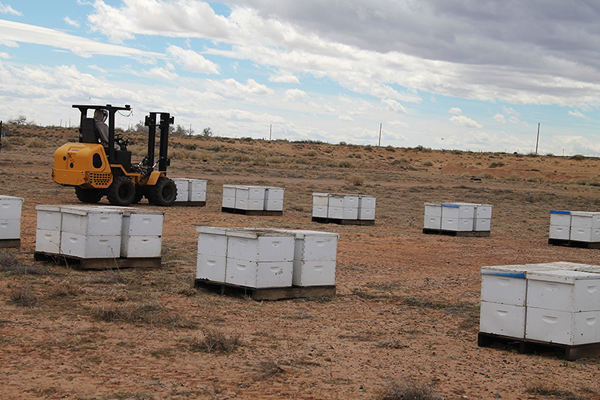
Preparing the hives for inspection, Joey Wroten arranges pallets of tens of thousands of bees into rows at a staging area in Belen. Once the hives are checked, they will be placed through out the valley for the summer.
There is some debate about whether honey sold in large stores is “real” honey. Costanza says it is, but it’s undergone more processing than the honey he and other local beekeepers typically sell.
“No. 1, honey will crystallize over a period of time. People do not understand the crystallization and they think that the honey’s gone bad.”
The crystals are typically caused by pollen in the honey, so large sellers will filter their product.
“But the pollen is the best part of the honey for health purposes,” Costanza said.
Honey is also homogenized — different batches are mixed together — and pasteurized by heating it to more than 160 degrees for 10 minutes. Costanza also noted that if a honey producer adds anything such as sugar or corn syrup, by law that has to be noted on the label.
“So, it’s real honey,” he said. “But they’ve done some things to it and there’s reasons they’ve done things to it, where as we’re trying to keep flavors distinct.”
Costanza’s hives are placed throughout the Rio Grande Valley, from Lemitar all the way north to Española. There are typically 25 to 50 hives at a location, which makes maintaining the hives easier for the company.
Every location will produce different flavors, from alfalfa blooms and purple sage in Valencia County to a hint of roses from hives in Albuquerque.
“So many people are trying to grow something and if they are growing something that requires pollination like melons and cantaloupe and tomatoes, cucumbers, they need some type of pollinator,” Costanza said.
For more information about bees, beekeeping and A-Bee Honey, visit nmhoney.com.
Julia M. Dendinger began working at the VCNB in 2006. She covers Valencia County government, Belen Consolidated Schools and the village of Bosque Farms. She is a member of the Society of Professional Journalists Rio Grande chapter’s board of directors.
